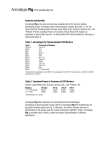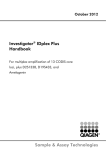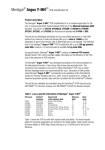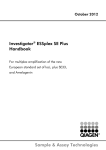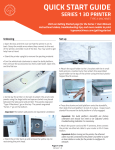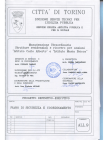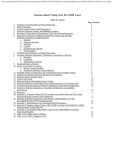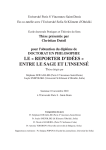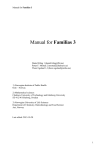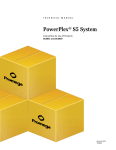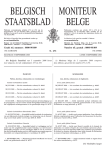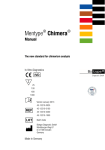Download 080627_Mentype Triplex TVD_engl
Transcript
Mentype® Triplex TVD PCR Amplification Kit Product Description Mentype® Triplex TVD is a complement to the Mentype® PCR Amplification Kits for fast and reliable DNA genotyping of blood, buccal swabs and forensic stains. In one PCR reaction, the three polymorphic tetranucleotide Short Tandem Repeat (STR) loci TH01 (TC11), vWA, and D21S11 are amplified simultaneously. One primer of each locus is fluorescence-labelled with 6-FAM. Mentype® Triplex TVD is preferentially employed for low copy and degraded DNA samples which do not give distinct results with complex multiplexes. The detection limit of Mentype® Triplex TVD PCR Amplification Kit is about 100 pg genomic DNA. The use of 0.1-1.0 ng DNA is recommended. Validation and evaluation of the test kit have been performed for the GeneAmp® 9700 thermal cycler, ABI PRISM® 310 Genetic Analyzer, and ABI PRISM® 3100/3130 Genetic Analyzer. Table 1. Locus-Specific Information of Mentype® Triplex TVD D21S11 GenBank® Accession AP000433 TH01 (TC11) vWA D00269 M25858 Locus Repeat Motif of the Reference Allele [TCTA]4 [TCTG]6 [TCTA]3 TA [TCTA]3 TCA [TCTA]2 TCCATA [TCTA]11 [TCAT]9 TCTA [TCTG]4 [TCTA]13 Reference Allele 29 Allele Range 24-46 9 18 3-14 10-25 The repeat motifs shown in Table 1 are concordant with the International Society for Forensic Genetics (ISFG) guidelines for the use of microsatellite markers (Bär et al., 1997). Table 2. Chromosomal Mapping of Mentype® Triplex TVD Locus D21S11 TH01 vWA Chromosomal Mapping 21q21.1 11p15.5pter 12p13.31 2 Content Mentype® Triplex TVD PCR Amplification Kit (100 Reactions) Nuclease-free Water Reaction Mix A Primer Mix Control DNA XY1 (2 ng/µL) DNA Size Standard 550 (ROX) Allelic Ladder 3.0 mL 500 µL 250 µL 10 µL 50 µL 10 µL Ordering Information Mentype® Triplex TVD Mentype® Triplex TVD Mentype® Triplex TVD 25 100 400 Reactions Reactions Reactions Cat. No. Cat. No. Cat. No. 41-03313-0025 41-03313-0100 41-03313-0400 Storage Store all components at –20°C and avoid repeated thawing and freezing. Primer Mix and Allelic Ladder must be stored protected from light. The DNA samples and postPCR reagents (Allelic Ladder and DNA Size Standard) should be stored separately from the PCR reagents. The expiry date is indicated on the kit cover. Quality Assurance The content of Biotype® test kits is subjected to an intensive quality assurance of the Biotype AG. The quality of test kits is controlled continuously in order to document the unrestricted usability. For questions regarding the quality assurance, please feel free to contact us. Mentype® Triplex TVD December 2007 3 Additional Required Reagents In order to use the Biotype® PCR Amplification Kit additional reagents are needed. We strongly recommend the application of the following products: Reagent JumpStart™ Taq DNA Polymerase hot start, 2.5 U/µL, 50 U or 250 U Hi-Di™ Formamide, 25 mL Matrix Standards (DS-30) for ABI PRISM® 310 Genetic Analyzer and ABI PRISM® 377 DNA Sequencer Matrix Standards (DS-30) for ABI PRISM® 3100/3130 and ABI PRISM® 3700/3730 Supplier Order Number Sigma-Aldrich D4184 Applied Biosystems 4311320 Applied Biosystems 401546 and 402996 (NED) Applied Biosystems 4345827 Trademarks and Patents Mentype® is a registered trademark of Biotype AG. JumpStart™ is a registered trademark of Sigma-Aldrich. ABI PRISM®, GeneScan®, Genotyper®, GeneMapper™ and Applied Biosystems are registered trademarks of Applera Corporation or its subsidiaries in the U.S. and certain other countries. 6-FAM, HEX, NED, ROX, POP-4, and Hi-Di are trademarks of Applera Corporation. GeneAmp® is a registered trademark of Roche Molecular Systems. The PCR is under patent law. Patentees are Hoffmann-La Roche Inc. and F. HoffmannLa Roche (Roche). DyeEx™ is a registered trademark of Qiagen. GenBank® is a trademark of National Institute of Health. Warning and Safety Instructions The PCR Amplification Kit contains the following potentially hazardous chemical: Kit Component Primer Mix, Reaction Mix and Allelic Ladder Chemical sodium azide NaN3 Danger very toxic if swallowed, develops toxic gases when it gets in contact with acids For the Material Safety Data Sheet (MSDS) of all Biotype® products, please contact us. For MSDS of additional reagents to be needed, please contact the corresponding manufactures. Mentype® Triplex TVD December 2007 4 Content 1. PCR Amplification.......................................................................................... 5 1.1 Master Mix Preparation ........................................................................... 5 1.2 PCR Amplification Parameter ................................................................... 6 2. Electrophoresis using the ABI PRISM® 377 DNA Sequencer............................. 7 2.1 Polyacrylamide-Gel (5%).......................................................................... 7 2.2 Sample Preparation................................................................................. 7 2.3 Setting for GeneScan® Software .............................................................. 8 3. Electrophoresis using the ABI PRISM® 310 Genetic Analyzer ........................... 9 3.1 Matrix Generation.................................................................................... 9 3.2 Sample Preparation............................................................................... 12 3.3 Setting for GeneScan® Software ............................................................ 12 3.4 Analysis Parameter ............................................................................... 13 4. Electrophoresis using the ABI PRISM® 3130/3130xl Genetic Analyzer ............ 14 4.1 Spectral Calibration / Matrix Generation.................................................. 14 4.2 Sample Preparation............................................................................... 17 4.3 Setting for GeneMapper™ ID Software .................................................. 17 4.4 Analysis Parameter (Analysis Method) .................................................... 19 5. Analysis...................................................................................................... 20 5.1 Controls................................................................................................ 21 5.2 Lengths of Fragments and Alleles .......................................................... 21 6. Interpretation of Results............................................................................... 24 Mentype® Triplex TVD December 2007 5 Protocols for PCR Amplification, Electrophoresis, and Analysis 1. PCR Amplification 1.1 Master Mix Preparation The table below shows the volumes of all PCR reagents per 25 µL reaction volume including a DNA sample volume of 3.0 µL (template DNA). Determine the number of reactions to be set up, positive control and negative control reactions should be included. Add one or two reactions to this number to compensate the pipetting error. Volume in [µL] Nuclease-free Water Reaction Mix A* Primer Mix Taq DNA Polymerase (hot start, 2.5 U/µL) Volume of Master Mix 1 14.1 5.0 2.5 0.4 22.0 Number of PCR-Reactions 10 25 141.0 352.5 50.0 125.0 25.0 62.5 4.0 10.0 220.0 550.0 100 1410.0 500.0 250.0 40.0 2200.0 * contains Mg2+, dNTP Mix, BSA All components should be mixed (vortex) and centrifuged for about 10 s before preparation of the Master Mix. The DNA volume applied to the assay depends on its respective concentration. An increase of DNA volume to more than 5 µL is not recommended, because potential PCR inhibitors may interfere. Adjust the final reaction volume with Nuclease-free Water to 25 µL. Generally, store DNA templates in Nuclease-free Water or in diluted TE buffer (10 mM Tris HCl, pH 8.0 and 1 mM EDTA), e. g. 0.1x TE buffer. The Primer Mixes are adjusted for balanced peak heights with 30 PCR cycles and 0.1-1.0 ng Control DNA XY1 in a reaction volume of 25 µL. If more DNA template is introduced, higher peaks will be expected for small PCR fragments and relatively low peaks for larger fragments. Reduce the amount of template DNA to correct this imbalance. Positive Control For the positive amplification control, dilute the Control DNA XY1 to 0.1-1.0 ng in the appropriate volume. Instead of the template DNA pipette the diluted Control DNA into a reaction tube containing the PCR Master Mix. Negative Control For the negative amplification control, pipette Nuclease-free Water instead of template DNA into a reaction tube containing the PCR Master Mix. Mentype® Triplex TVD December 2007 6 1.2 PCR Amplification Parameter In order to activate the Taq DNA Polymerase and to prevent the formation of nonspecific amplification products, perform a “hot start“ PCR reaction. The number of cycles depends on the amount of DNA. For all samples, 30 cycles are recommended. For stains with small amounts of genomic DNA 34 cycles are recommended optionally in order to achieve optimal signal intensities. Standard Method Recommended for all DNA Samples Temperature 94°C 94°C 58°C 72°C 68°C 10°C Time 4 min (hot start for Activation of the JumpStart™ Taq DNA Polymerase) 30 s 30 Cycles 120 s 75 s 60 min ∞ hold Optional Recommended for Stains with small Amounts of DNA Temperature 94°C 94°C 58°C 72°C 68°C 10°C Time 4 min (hot start for Activation of the JumpStart™ Taq DNA Polymerase) 30 s 34 Cycles 120 s 75 s 60 min ∞ hold Small amounts of DNA might result in allelic dropouts and imbalances of the peaks. Furthermore, unspecific amplification products could appear. With increasing numbers of cycles, cross contaminations could be emerged because of minimal amounts of impurities. Mentype® Triplex TVD December 2007 7 2. Electrophoresis using the ABI PRISM® 377 DNA Sequencer For general instructions on instrument setup, matrix generation and application of the GeneScan® analysis Software, please read the ABI PRISM ® 377 DNA Sequencer User’s Manual. Electrophoresis by using the GeneScan® Software is described below. For the combined application of the four fluorescent dyes 6-FAM, HEX, NED, and ROX (also called DS-30) the use of the virtual Filter Set D is allocated. Generally, Filter Sets A and F are suitable, too. Prior to any analysis of DNA fragment size a matrix with the appropriate four fluorescent dyes has to be generated for the instrument. Appropriate matrix standards can be purchased from Applied Biosystems. 2.1 Polyacrylamide-Gel (5%) Composition Urea 30% Acrylamide / bisacrylamide solution (29:1) 10x TBE buffer Water Filtrate and degas solution 10% Ammonium persulfate TEMED Use glass plates with a spacing of 36 cm Amount/Volume 21.0 g 8.4 mL 6.0 mL 20.0 mL 350 µL 15 µL 2.2 Sample Preparation Composition Hi-Di™ Formamide / Blue Dextran DNA Size Standard 550 (ROX) PCR product (diluted if necessary) or Allelic Ladder - 3 min denaturation at 95°C - cooling at 4°C - apply 1.5 µL sample to the gel Mentype® Triplex TVD Volume 1.5 µL 0.5 µL 1.0 µL December 2007 8 2.3 Setting for GeneScan® Software Plate Check Module D PreRun Module "GS PR 36D - 1200" Run Module "GS Run 36D - 1200" Matrix D (6-FAM, HEX, NED, ROX) Standard SST550 (ROX) Programming of the Run Module for Biotype® Test Kits (6-FAM / HEX / NED / ROX) - Open program "377 Collection" - Open File - New - GeneScan Run - Select the module "GS Run 36D -1200" in the run window - Click at the sheet symbol in the run window - Use the following settings: Parameter Voltage Current Power Collection time Gel temperature Laser power Setting 3000 V 50.0 mA 150 W 2.7 h 51°C 40.0 mW Mentype® Triplex TVD Save the module in the field „Save Copy“ December 2007 9 3. Electrophoresis using the ABI PRISM® 310 Genetic Analyzer For general instructions on instrument setup, matrix generation and application of the GeneScan® or GeneMapper™ ID Software, please read the ABI PRISM ® 310 Genetic Analyzer User’s Manual. Electrophoresis by using the GeneScan® Software is described below. For the combined application of the four fluorescent labels 6-FAM, HEX, NED, and ROX (also called DS-30) the use of the virtual Filter Set D is allocated. Generally, Filter Sets A and F are suitable, too. Material Capillary Polymer Buffer 47 cm / 50 µm (green) 310 Genetic Analyzer POP-4 10x Genetic Analyzer Buffer with EDTA 3.1 Matrix Generation Prior to any analysis of DNA fragment size a matrix with the appropriate four fluorescent labels has to be generated. Appropriate matrix standards can be purchased from Applied Biosystems. Dye Color Blue (B) Green (G) Yellow (Y) Red (R) Matrix Standard 6-FAM HEX NED ROX Order Number Applied Biosystems, 401546 Applied Biosystems, 401546 Applied Biosystems, 402996 Applied Biosystems, 401546 To generate useful matrix files, it is necessary to perform four electrophoresis runs with the matrix samples (PCR fragments labelled with 6-FAM, HEX, NED, and ROX). The runs have to be done under the same conditions like for the samples and the Allelic Ladders of the Biotype® test kit. Matrix sample Composition Hi-Di™ Formamide Matrix Standard 6-FAM Volume 12.5 µL 1.0 µL Matrix sample 2 Hi-Di™ Formamide Matrix Standard HEX 12.5 µL 1.0 µL Matrix sample 3 Hi-Di™ Formamide Matrix Standard NED 12.5 µL 1.0 µL Matrix sample 4 Hi-Di™ Formamide Matrix Standard ROX 12.5 µL 1.0 µL Matrix sample 1 - 3 min denaturation at 95°C - cooling at 4°C - for analysis: load the samples on the tray - Create a Sample Sheet and enter sample designation Mentype® Triplex TVD December 2007 10 Injection List for Matrix Generation Injection list Module File Matrix File Size Standard* Injection [s] Injection [kV] Run [kV] Run [°C] Run Time [min] GS STR POP-4 (1 mL) D NONE NONE 5 15.0 15.0 60 24 * prepare Matrix Standards always without DNA Size Standard (ROX) Analysis of the Matrix Samples - Open GeneScan® or GeneMapper™ ID Software - FILE → NEW → PROJECT (open current run folder) → ADD SAMPLE FILES - Click a single matrix sample in the column SAMPLE FILE - Select SAMPLE → RAW DATA - Review the matrix samples for a flat baseline beyond the primer peak. There should be at least five peaks with peak heights about 400-4000 (Y) in every matrix sample (optimal range: 1000-3000), as shown in Fig. 1 ▼ 3400 Data Points (X) 6400▼ Fig. 1 Electropherogram with Raw Data of the Matrix Standard 6-FAM - Select analysis range with flat baseline - Re-inject the matrix sample if necessary - Note start and end value (Data Points) of the analysis range, e. g. start value 3400, end value 6400 - Calculate the difference value, e. g. 6400-3400 = 3000 Data Points Mentype® Triplex TVD December 2007 11 Generation of a New Matrix - FILE → NEW → MATRIX, as shown in Fig. 2 Fig. 2 Select Matrix Samples - Import matrix samples for all dyes (B, G, Y, R) - Enter „Start At“ value, e. g. 3400 - Enter difference value at Points, e. g. 3000 - Select OK to calculate the new matrix, as shown in Fig. 3 Fig. 3 New Matrix Biotype - Save in the Matrix Folder: FILE → SAVE AS, e. g. Matrix Biotype Matrix Check Please check the new matrix with current samples. - FILE → NEW → PROJECT (open run folder) → ADD SAMPLE FILES - Select sample(s) in the column SAMPLE FILE - SAMPLE → INSTALL NEW MATRIX (open matrix folder and select new matrix) - Re-Analyse your samples With the new matrix there should be no pull-up peaks between the dye panels (B, G, Y, R). Mentype® Triplex TVD December 2007 12 3.2 Sample Preparation Composition Hi-Di™ Formamide DNA Size Standard 550 (ROX) prepare 12 µL of the mix (Formamide + DNA Size Standard) for all samples add 1 µL PCR product (diluted if necessary) or Allelic Ladder - 3 min denaturation at 95°C - cooling at 4°C - for analysis: load the samples on the tray Volume 12.0 µL 0.5 µL Signal Intensities In order to increase the intensity of signals: - Reduce the volume of the DNA Size Standard 550 (ROX); the peaks of the Size Standard should be about 500 relative fluorescent units (RFU) - Purify the PCR products with DyeEx™ 2.0 Spin Kit, Qiagen (63204) 3.3 Setting for GeneScan® Software - Create a Sample sheet and enter sample designation Injection List Module File Matrix File Size Standard Injection [s]* Injection [kV] Run [kV] Run [°C] Run Time [min]** GS STR POP-4 (1 mL) D e. g. Matrix Biotype e. g. SST550_50-400bp 5 15.0 15.0 60 24 * Apart from standard settings, the injection time may range between 1 and 10 s depending on the type of sample. If blood samples with very high signal intensities are to be recorded, a shorter injection time may be selected. For samples with low DNA content an injection time up to 10 s may be necessary. ** Depending on the analysis conditions the Run Time for Mentype® Triplex TVD was modified in order to analyze lengths of fragments up to 280 bp. Mentype® Triplex TVD December 2007 13 3.4 Analysis Parameter The recommended analysis parameters are: Analysis Range Start: 2000 Stop: 10000 Baseline: Checked Multicomponent: Checked Smooth Options: Light Peak Amplitude Thresholds B:* Y:* G:* R:* Min. Peak Half Width: 2 pts Polynorminal Degree: 3 Peak Window Size: 11 pts** Min: 50 Max: 550 Local Southern Method None Data Processing Peak Detection Size Call Range Size Calling Method Split Peak Correction * The peak amplitude threshold (Cutoff value) corresponds to the minimum peak height that will be detected from the GeneScan® or GeneMapper™ ID Software. Thresholds are usually 50-200 RFU and should be determined individually by the laboratory. Recommendation: The minimal peak height should be three times higher then the background noise of the baseline. ** Sometimes, point alleles (i. e. alleles with at least 1 bp difference to the next integer allele) like TH01 allele 9.3 and 10 can not be distinguished. For improved peak detection, minimize the Peak Window Size further on. Mentype® Triplex TVD December 2007 14 4. Electrophoresis using the ABI PRISM® 3130/3130xl Genetic Analyzer For detailed instructions on instrument setup, spectral calibration, or application of the ABI PRISM® Data Collection Software and the GeneMapper™ ID Software, refer to the ABI PRISM ® 3130/3130xl Genetic Analyzers Getting Started Guide. Electrophoresis by using the GeneMapper™ ID Software is described below. The 4-Capillary-System is named ABI 3130 (before ABI 3100-Avant), the 16-CapillarySystem is named ABI 3130xl (before ABI 3100). For the combined application of the four fluorescent labels 6-FAM, HEX, NED, and ROX (also called DS-30) the use of the Dye Set D is allocated. Material Capillary Polymer Buffer 3130 capillary array, 36 cm 3130 POP-4 polymer 10x Genetic Analyzer Buffer with EDTA 4.1 Spectral Calibration / Matrix Generation Prior to any analysis of DNA fragment size a spectral calibration with the four florescent labels 6-FAM, HEX, NED and ROX has to be generated for each analyzer. The spectral calibration creates a matrix to correct the overlapping of fluorescence emission spectra of the dyes. Performing a spectral calibration can be divided into the following tasks: - Choosing and setting up the Spectral Calibration Standards - Loading the standards on the 96-well reaction plate (per capillary one sample) - Creating the instrument protocol for performing spectral calibration (Protocol Manager) - Define the plate assembly within the plate editor (Plate Manager) - Performing a spectral calibration run and reviewing data Mentype® Triplex TVD December 2007 15 Setting up the Spectral Calibration Standards Example for 4 Capillaries/ABI 3130 Composition Volume Hi-Di™ Formamide 47.5 µL Matrix Standard 2.5 µL - 3 min denaturation at 95°C - cooling at 4°C - for analysis, load 10 µL of the Matrix Standard into a 96-well reaction plate, well A1-D1 Example for 16 Capillaries/ABI 3130xl Composition Volume Hi-Di™ Formamide 190 µL Matrix Standard 10.0 µL - 3 min denaturation at 95°C - cooling at 4°C - for analysis, load 10 µL of the Matrix Standard into a 96-well reaction plate, well A1-H1 and A2-H2 Performing Spectral Calibration Run - Insert the 96-well plate on the autosampler tray - In the Protocol Manager of the Data Collection Software click New in the window Instrument Protocol to open the Protocol Editor dialog box Instrument Protocol for Spectral Calibration Protocol Editor Name Type Dye Set Polymer Array Length Chemistry Run Module e. g. Spectral36_POP4_DS30 SPECTRAL D POP4 36 Matrix Standard Spect36_POP4_1 - Select OK to complete the Protocol Editor dialog box Mentype® Triplex TVD December 2007 16 - In the Plate Manager of the Data Collection Software click New to open the New Plate Dialog box Plate Editor for Spectral Calibration (I) New Plate Dialog Name Application Plate Type Owner Name / Operator Name e. g. Spectral_DyeSet D_Date Spectral Calibration 96-Well … - Select OK to complete the New Plate dialog box. A new table in the Plate Editor opens automatically - For further analyses for spectral calibration use the same plate setting, click Import, select the .xml file and click Open Plate Editor for Spectral Calibration (II) Column Name Sample Name Priority Instrument Protocol 1 Type name for the matrix samples e. g. 100 Spectral36_POP4_DS30 (setting described before) - For each of the columns, click the column header to select entire column, then select Edit → Fill Down to apply the information to all of the selected samples, and enter OK - In Run Scheduler click Find All, select link to link up the reaction plate on the autosampler with the newly created plate record (position A or B) and start the run - View Pass/Fail Status after the run in the Event Log and open the Spectral Viewer to review and evaluate the spectral calibration profile for each capillary Fig. 4 Electropherogram with Raw Data of the Matrix Standard for DS-30 Note: If all capillaries passed the test, activate this Spectral Calibration file for Dye Set D in the Spectral Viewer. Mentype® Triplex TVD December 2007 17 4.2 Sample Preparation Composition Volume Hi-Di™ Formamide 12.0 µL DNA Size Standard 550 (ROX) 0.5 µL prepare 12 µL of the mix (Formamide + DNA Size Standard) for all samples add 1 µL PCR product (diluted if necessary) or Allelic Ladder - 3 min denaturation at 95°C - cooling at 4°C - for analysis: load the samples on the tray Because injections proceed simultaneously for all capillaries, four samples must be pipette for analysis on 4-capillary analysers. If less then four samples are analysed, fill up the empty positions on the plate with 12 µL Hi-Di™ Formamide. For reliable allelic assignment on 4-capillary analysers, one Allelic Ladder per capillary should be run. The room temperature might influence the running performance of PCR products that might result in split peaks especially at low temperatures or an altered run velocity of DNA fragments. Please pay attention to keep conditions recommended by the instrument manufacturer. 4.3 Setting for GeneMapper™ ID Software Performing Run - Insert the 96-well plate prepare on the autosampler tray - In the Protocol Manager of the Data Collection Software click New in the window Instrument Protocol to open the Protocol Editor dialog box Instrument Protocol Protocol Editor Name Type Run Module* Dye Set Run36_POP4_DyeSet D REGULAR HIDFragmentAnalysis36_POP4_1 D * for detailed description see Setting of the Run Module on the next page - Select OK to complete the Protocol Editor dialog box Mentype® Triplex TVD December 2007 18 Previous to the first run, it is necessary to edit the Run Module as follows: - In the Module Manager of the Data Collection Software click New to open the Run Module Editor dialog box Run Module (15min_50-400bp) Run Modul Editor Oven Temperature [°C] Poly Fill Volume Current Stability [µA] PreRun Voltage [kV] PreRun Time [s] Injection Voltage [kV] Injection Time [s]* Voltage Number of Steps Voltage Step Interval Data Delay Time [s] Run Voltage [kV] Run Time [s]** Value 60 4840 5 15 180 3.0 5 40 15 1 15.0 900 * Apart from standard settings, the injection time may range between 1 and 20 s depending on the type of sample. If samples with very high signal intensities are to be recorded, a shorter injection time may be selected. For samples with low DNA content an injection time up to 20 s may be necessary. ** Depending on the analysis conditions the Run Time for Mentype® Triplex TVD was modified in order to analyze lengths of fragments up to 280 bp. - Click Save As and enter the name of the new module (e. g. 15min_50-400bp) and enter OK - Click Close to exit the Module Editor Previous to every run, it is necessary to compile the plate as follows: - In the Plate Manager of the Data Collection Software click New to open the New Plate Dialog box GeneMapper™ Plate Editor (I) New Plate Dialog Name Application Plate Type Owner Name / Operator Name e. g. Plate_DyeSet D_Date select GeneMapper Application 96-Well … - Select OK to complete the New Plate dialog box. A new table in the Plate Editor opens automatically Mentype® Triplex TVD December 2007 19 GeneMapper™ Plate Editor (II) Column Name Sample Name Priority Sample Type Size Standard Panel Analysis Method Snp Set User-defined 1-3 Results Group 1 Instrument Protocol 1 Type name for the samples e. g. 100 (Default) Sample or Allelic Ladder e. g. SST550_50-400bp e. g. Biotype_Panels_v1 (choose test kit) e. g. Analysis_HID_3130 (select results group) Run36_POP4_DyeSet D (setting typed before) - For each of the columns, click the column header to select entire column, then select Edit → Fill Down to apply the information to all of the selected samples and enter OK - In Run Scheduler click Find All, select link to link up the reaction plate on the autosampler with the newly created plate record (position A or B) and start the run - During the run, view Error Status in the Event Log or examine the quality of the raw data for each capillary in the Capillaries Viewer or the Cap/Array Viewer - View data as overview in Run History or Cap/Array Viewer of the Data Collection Software. Run data are saved in the Run Folder of the former chosen Result Group 4.4 Analysis Parameter (Analysis Method) The recommended settings in the worksheet Peak Detector are: Peak Detection Algorithm Ranges Smoothing and Baselining Size Calling Method Peak Detection Advanced Analysis: Partial Range Start Pt: 2000; Stop Pt: 10000 Sizing: All Sizes Smoothing: Light Baseline Window: 51 pts Local Southern Method Peak Amplitude Thresholds B:* Y:* G:* R:* Min. Peak Half Width: 2 pts Polynominal Degree: 3 Peak Window Size: 11 pts** Slope Thresholds: 0.0 * The peak amplitude threshold (Cutoff value) corresponds to the minimum peak height that will be detected from the GeneMapper™ ID Software. The thresholds are usually 50-200 RFU and should be determined individually by the laboratory. Recommendation: The minimal peak height should be three times higher then the background noise of the baseline. ** Sometimes, point alleles (i. e. alleles with at least 1 bp difference to the next integer allele) like THO1 allele 9.3 and 10 can not be distinguished. For improved peak detection, minimize the Peak Window Size further on. Mentype® Triplex TVD December 2007 20 5. Analysis For general instructions on automatic sample analysing, please read the GeneScan® or GeneMapper™ ID Software User’s Manual. The determination of the exact lengths of the amplified products depends on the type of device, on the conditions of electrophoresis, as well as on the DNA Size Standard used. Due to the complexity of some STR loci, the size determination should be based on evenly distributed points of references. Thus, please use the DNA Size Standard 550 (ROX) with the following lengths of fragments: 50, 60, 70, 80, 90, 100, 120, 140, 160, 180, 190, 200, 220, 240, 260, 280, 300, 320, 340, 360, 380, 400, 425, 450, 475, 500, 525 and 550 bp. Fig. 5 Electropherogram of the DNA Size Standard 550 (ROX), Lengths of Fragments in bp Allele designation of analyzed samples should be carried out either manually or with suitable analysis software, e. g. GeneMapper™ ID or Genotyper® Software in combination with the Mentype® Triplex TVD Template File from Biotype AG. Template Files can be received as free downloads from our homepage (www.biotype.de) or as CD-ROM on request. Mentype® Triplex TVD December 2007 21 5.1 Controls The Control DNA XY1 of the PCR Amplification Kit, and those DNA commonly available from standard cell lines, represent the following alleles: Table 3. Allele Determinations of Mentype® Triplex TVD Locus D21S11 THO1 vWA Control DNA XY1 27 / 28 6 / 9.3 15 / 18 ATCC K-562 29 / 30 / 31 9.3 / 9.3 16 / 16 CCR 9947A 30 / 30 8 / 9.3 17 / 18 CCR 9948 29 / 30 6 / 9.3 17 / 17 CCR 3657 28 / 29 7 / 9.3 14 / 19 For further confirmation, the table above displays the alleles of the reference DNA K562 purchased from ATCC (http://atcc.org/Produtcs/PurifiedDNA.cfm#celllines) as well as three reference DNA purchased from Coriell Cell Repositories (CCR; http://locus.umdnj.edu/nigms/) that is up to standard of Szibor et al. (2003). 5.2 Lengths of Fragments and Alleles Table 4 displays the values for all lengths of fragments of individual alleles that refer to the DNA Size Standard 550 (ROX). All analyses have been performed on an ABI PRISM® 310 Genetic Analyzer with POP-4 polymer. Different analysis instruments, DNA Size Standards or polymers might result in different lengths of fragment. These data could serve as approximate allele sizes for the creation of a new analysis template. In order to balance instrument-specific deviations further fine tuning of the equipment should be done by measuring sample fragments of known lengths. In addition, a visual alignment with the Allelic Ladder is recommended. Scaling Horizontal: 55-285 bp Vertical: Depending on signal intensity Mentype® Triplex TVD December 2007 22 Figure 6 A Mentype® Triplex TVD B December 2007 Fig. 6 Electropherogram of the Mentype® Triplex TVD using 100 pg Control DNA XY1 (B) and the Allelic Ladder (A). Analysis was done on an ABI PRISM® 310 Genetic Analyzer using the DNA Size Standard 550 (ROX). Allele assignment was performed using the Genotyper® Software and the Mentype® Triplex TVD Template File. 23 Table 4. Fragment Lengths of the Allelic Ladder Mentype® Triplex TVD analysed on an ABI PRISM® 310 Genetic Analyzer Allele Size [bp] Further Alleles* ABI 310 Allele Size [bp] ABI 310 TH01 6-FAM vWA 6-FAM 5 72.8 3b, 4b, 5.3b 11 121.2 6 76.6 6.1b, 6.3c 12 7 80.6 7.1b, 7.3c 8 85.0 9 89.3 9.3 Further Alleles* Allele Size [bp] ABI 310 Further Alleles* D21S11 6-FAM 25 186.0 24a, 24.2c, 24.3b 25.2c, 25.3b 125.3 26 190.0 26.1b, 26.2c 13 129.4 27 194.2 27.1b, 27.2a, 27.3b 8.3c 14 133.9 28 198.3 28.2c, 28.3c 9.1c 15 138.1 15.2b 29 202.3 29.1b 92.3 16 142.1 16.1b 29.2 204.3 29.3a 10 93.3 17 146.1 30 206.2 30.1b, 30.2c, 30.3a 10.3 96.3 18 149.7 31 210.2 31.1b 13 105.5 19 153.7 31.2 212.2 31.3b 13.3 108.7 20 157.7 32 214.2 32.1b 21 161.8 32.2 216.2 32.3b 33 218.2 33.1c 33.2 220.2 33.3b 34 222.2 34.1c 34.2 224.2 34.3b 35 226.2 35.1b, 35.2c, 35.3b, 36.1b, 36.2c, 36.3b 37 234.4 37.2b, 38a, 38.2b, 39b, 39.2d, 40.2d, 41.2d, 46e 11c, 12b 14b 10b 18.2b, 18.3b 22c, 23b, 24b, 25b * a. http://www.uni-duesseldorf.de/WWW/MedFak/Serology/database.html, b. http://www.cstl.nist.gov/biotech/strbase/str_fact.htm, c. Biotype AG (DNA pool), d. Ayres et al. (2002), e. Grubwieser et al. (2005) Mentype® Triplex TVD December 2007 24 6. Interpretation of Results As mentioned above, post PCR analysis and automatic allele allocation with suitable analysis software ensure a precise and reliable discrimination of alleles. Pull-up Peaks If peak heights are outside the linear detection range (>3000 RFU) or if an incorrect matrix has applied, pull-up peaks can occur at positions of specific peaks in all colour channels. In order to avoid pull-up peaks, peak heights should not exceed more than 3000 RFU. Stutter Peaks Appearance of stutter peaks depends on the sequence of the repeat structure and on the number of alleles. n-4 peaks are due to a loss of a repeat unit during amplification of tetranucleotide STR motives caused by slippage effects of the DNA polymerase. Interpretation of those peaks should be done in accordance with the Template Files of the Genotyper® and GeneMapper™ ID Software. Template-independent Nucleotide Addition The terminal transferase activity of Taq DNA polymerase leads to the addition of an adenosine residue preferentially at the 3’-end of amplified DNA fragments. Incomplete extension is responsible for double peaks, resulting from the absence of the terminal adenosine residue. The artefact peak is one base shorter than expected (-1 peaks). All Biotype® primers are designed to minimize these artefacts. In addition, the final extension step of 68°C for 60 minutes is included to the PCR protocol in order to reduce formation of artefacts. Peak height of the artefact correlates with the amount of DNA. Every laboratory should determine their own thresholds for analysis of the peaks. Mentype® Triplex TVD December 2007 25 References Ayres KL, Chaseling J, Balding DJ (2002) Implications for DNA identification arising from an analysis of Australian forensic database. Forensic Sci. Int. 129: 90-98. Bär W, Brinkmann B, Budowle B, Carracedo A, Gill P, Lincoln P, Mayr W, Olaisen B (1997) DNA recommendations. Further report of the DNA Commission of the ISFH regarding the use of short tandem repeat systems. Int. J. Legal Med. 110: 175-176. Gill P, Brenner CH, Buckleton JS, Carracedo A, Krawczak M, Mayr, WR, Morling N, Prinz M, Schneider PM, Weir BS (2006) DNA Commission of the International Society of Forensic Genetics (ISFG): Recommendations on the interpretation of mixtures. Forensic Sci Int. Jul 13;160 (2-3):90-101. Griffiths RA, Barber MD, Johnson PE, Gillbard SM, Haywood MD, Smith CD, Arnold J, Burke T, Urquhart AJ, Gill P (1998) New reference allelic ladders to improve allelic designation in a multiplex STR system. Int. J. Legal Med. 111: 267-272. Grubwieser P, Muhlmann R, Niederstätter H, Pavlic M, Parson W. (2005) Unusual variant alleles in commonly used short tandem repeat loci. Int J Legal Med. 2005 Jan 5. Szibor R, Edelmann J, Hering S, Plate I, Wittig H, Roewer L, Wiegand P, Calì F, Romano V, Michael M (2003) Cell line DNA typing in forensic genetics – the necessity of reliable standards. Forensic Sci. Int. 138 37-43. Mentype® Triplex TVD December 2007 26 Notes Mentype® Triplex TVD December 2007 27 Notes Mentype® Triplex TVD December 2007 28 Notes Mentype® Triplex TVD December 2007




























